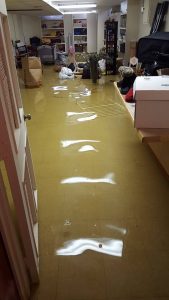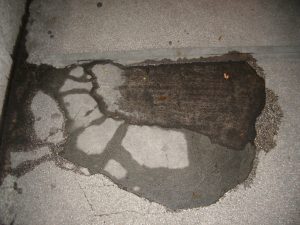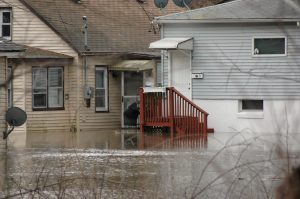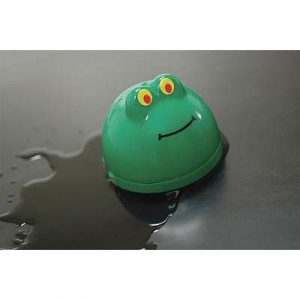
-
Locations: 68364 Main St. Richmond, MI 48062
422 Mill Street Ortonville, MI 48462 -
Call Verlinde: (586) 727-6525
(810) 636-9400 -
Email: jason@verlindeinsurance.com
Just what you don’t want to hear.
Dad: Susie, will you run down in the basement and bring me the crockpot?
Susie: DAAAAADDD!! Our basement is like a swimming Pool!!
As you walk down the steps you find four inches of water covering the entire basement floor. You see storage boxes completely soaked. Your son’s PlayStation is underwater. Water has started leaching up the drywall. You pick up the phone to call your Insurance Agent. “Hello I have water in my basement! Am I covered?”
The first question you are asked is “What is the source of the water?”
Depending on where the water came from, will determine if you do in fact have coverage for the loss. When water makes an unwelcome appearance in your basement it is usually from one of four sources.
#1: Water is from Broken / Leaking Plumbing Pipe – Covered
Photo by RoganJosh at Morguefile.com
If the source of the water in your basement is from a plumbing pipe that is inside your house, your homeowners policy will respond. You will have coverage for both the dwelling (floor coverings, drywall, furnace, water heater) as well as your contents (boxes, PlayStation, furniture). For this type of loss there are no special limits on the policy so you will have the full amount of dwelling and contents coverage that are listed on your policy available to you.
#2: Water is from Back-up of Sewer and Drains – Covered by Endorsement

Photo by Greener Method
This is the most frequent loss that we see. Water comes up thru the basement drain system or overflows from the sump pump crock. Unfortunately sump pumps do fail. They typically only last three to five years. A standard homeowners policy excludes coverage for this type of loss. In order for their to be coverage you have to have an Endorsement on your policy and yes it does cost a bit extra.
When purchasing the Back-up of Sewer and Drains endorsement you choose the amount of coverage that you need. The cost can range from $12-$20 per thousand dollars of coverage per year ($5000 of coverage would cost between $60-$100 per year). When choosing this amount be sure to keep in mind not only the cost of flooring, drywall, and your belongings but also the cost to adequately dry out the basement correctly (Which can cost $5000-$7500 alone).
#3: Water is from seepage thru the basement walls – Not Covered

Photo by AnomalousUnderdog at Morguefile.com
From time to time we do see this unfortunate loss. Water has found its way into your basement by seeping thru the basement wall itself. Most homeowners policies will exclude seepage. There are steps you can take to avoid a seepage problem.
- Make sure the ground around your home is graded correctly to divert water away from the exterior walls of your home.
- Keep gutters clean and operating properly.
#4: Water is from Surface water entering basement thru window or door-wall – Possible Coverage on a Flood Policy

Photo by kconnors at Morguefile.com
A standard homeowners policy excludes water damage caused by surface water. Depending on the circumstances there may be coverage if you have a separately purchased flood policy. For a flood policy to respond the surface water has to be a temporary condition where 2 or more acres of normally dry land or two or more properties are inundated by water or mudflow.
The cost of the additional flood policy can vary greatly depending on the location of your home and almost impossible to give a ballpark cost without a conversation with your agent.
You can find more info on the National Flood Insurance Program by visiting floodsmart.gov.
Tips and Tricks:
After determining if the damage is covered or not the next step is to start the repair process. We highly recommend getting a professional restoration company to start the drying out process as soon as possible. Although the process isn’t inexpensive it can save you in repair costs and they can typically save a lot of your contents by professionally cleaning. These companies have powerful extraction equipment, industrial fans and dehumidifiers. We recently had a client try to dry out their basement with a shop vac and fans for three days and was making little headway. After three days they started noticing a smell. The professionals were called in and the home was dry within 24 hours.
When storing your belongings in the basement we recommend using Rubbermaid totes in lieu of cardboard boxes. With just an inch or two of water a cardboard box (and its contents) will be ruined. A Rubbermaid tote will withstand a lot of water.

Another product that we love is “Leak Frog” water alarm. Place a couple of these cute little frogs in your basement and at the first sense of water they will set off an alarm that you can’t miss! You can purchase them from Amazon here.
If you have any questions or comments at all please comment here, reach out to us by phone/email/facebook/smoke signal…. Oh wait. Not smoke signal. We don’t want to discuss how your home is covered for fire!
Want to compare your options?
Click the button below to head to our quotes page where you can enter some basic information to have our team help with your insurance!
